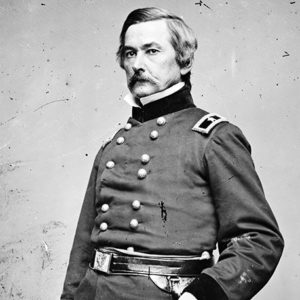calsfoundation@cals.org
Capture of St. Charles
| Location: | Arkansas County |
| Campaign: | White River Expedition (January 13–19, 1863) |
| Date: | January 13, 1863 |
| Principal Commanders: | Brigadier General Willis Gorman (US); None (CS) |
| Forces Engaged: | USS Cincinnati, USS Baron DeKalb, USS Romeo, USS Forest Rose, two infantry regiments (US); None (CS) |
| Estimated Casualties: | None (US); None (CS) |
| Result: | Union victory |
A bloodless engagement, the January 13, 1863, capture of St. Charles (Arkansas County) was part of a larger Federal movement up the White River after the capture of Fort Hindman earlier that month. St. Charles served as an important Confederate stronghold before its abandonment and subsequent capture.
Located on high ground on the west bank of the White River, St. Charles is the first defensible location north of the junction of the White and the Arkansas rivers. Fortified by Confederate forces in June 1862, St. Charles was attacked by Federal forces the same month. While Union troops did take St. Charles, it was only after a substantial engagement that saw massive casualties among the Federal sailors in the expedition. With falling water levels on the rivers, the town was quickly abandoned by Union troops and reoccupied by Confederate forces.
A second effort to take St. Charles and other towns located along the White River was launched after the fall of Fort Hindman at Arkansas Post to Federal forces on January 11, 1863. Brigadier General Willis Gorman worked with Acting Rear Admiral David Porter to secure transport up the White for 9,000 infantry, 2,000 cavalry, and twenty pieces of light artillery. In response to Gorman’s request for naval support, Porter provided the ironclads USS Cincinnati and USS Baron DeKalb, as well as the tinclads USS Romeo and USS Forest Rose. The army troops moved from Helena (Phillips County) to join the expedition.
Beginning the journey up the White River on January 13 in the rain, the ships were covered in snow by the next day. The Federal forces reached St. Charles that night and found the town abandoned by the Confederate troops tasked with defending it. Before withdrawing, the Confederates had loaded two eight-inch siege guns and six pieces of field artillery onto the steamer Blue Wing and moved upriver to DeValls Bluff (Prairie County).
Before leading the majority of his force in pursuit of the enemy on January 14, Gorman tasked an infantry regiment, an artillery battery, and two companies of cavalry, as well as the USS Cincinnati, with holding the town. The Federal troops in St. Charles burned much of the town throughout the next day. Gorman and the remainder of his force continued up the White and captured both DeValls Bluff and Des Arc (Prairie County). St. Charles remained in Federal hands for the remainder of the war.
While the capture of St. Charles proved to be anti-climactic, the importance of the city to Federal efforts in the state would help shape policy for the remainder of the Civil War.
For additional information:
Christ, Mark K. Civil War Arkansas, 1863: The Battle for a State. Norman: University of Oklahoma Press, 2010.
The War of the Rebellion: A Compilation of the Official Records of the Union and Confederate Armies. Series 1, Vol. 22, part I. Washington DC: Government Printing Office, 1889.
David Sesser
Henderson State University
 Civil War through Reconstruction, 1861 through 1874
Civil War through Reconstruction, 1861 through 1874 Military
Military Willis A. Gorman
Willis A. Gorman  USS Cincinnati
USS Cincinnati 




Comments
No comments on this entry yet.